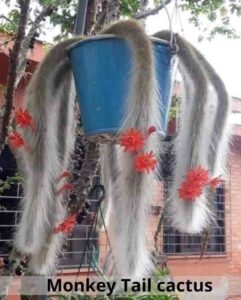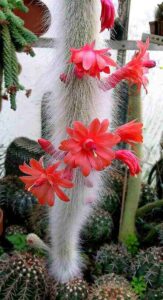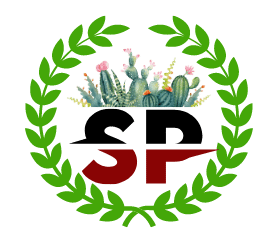Monkey Tail Cactus
Cleistocactus colademononis (previously Hildewintera colademononis), popularly known as Monkey tail cactus, is a vigorous tropical epilithic cactus branched at the base. This cactus species is preferred outdoors mostly as hanging plants for its unique drooping stems which can reach up to 3-4 feet in length. Its origin can be traced back to the Bolivian countryside in Santa Cruz where it can be found growing naturally on rocky soil. It is a rare, non-invasive and very sought after cactus.

They are famed for blooming sporadically throughout the year with its main season being summer and spring. This cactus thrives in USDA hardiness zones 9a – 11b. Unlike in other cacti, Monkey’s tail cactus have toxic flesh which is not edible. During their dormancy period, they can even survive temperatures lower than the freezing point which make this plant unique than other species. It may be confused with Cleistocactus winteri which is also called Golden Rat’s tail cactus but they differ in length and colour of spines.
Botanical Classification of Monkey Tail Cactus
Kingdom: Plantae
Clade: Tracheophytes
Clade: Angiosperms
Clade: Eudicots
Order: Caryophyllale
Family: Cactaceae
Sub-family: Cactoideae
Genus: Cleistocactus
Species: colademononis
Morphology of Monkey Tail Cactus
1. Stem

The stems look greenish when young and greenish-yellow when they get older and covered on the entire surface by white, long & soft hair like spines cascading downward which resembles the appearance of Monkey’s tail. They are branched to three to five stems at the bottom. The stems start drooping and become pendant after reaching a certain height. Each stem can increase in size by nearly a foot every year and reach to 3 or 4 feet length. These long protruding stems on the hanging basket makes the garden look really attractive. Their soft harmless appearance lures people to touch them but it is to be noted that the flesh of this cactus is non-edible.
2. Flowers

The flowers of Monkey Tail Cactus produce bright red flowers that make the plant look particularly fascinating and eye-catching. After a few days, the flowers turn into fruits and disappear shortly. They are popular for blooming throughout the year with summer and winter being the main season. The contrasting features of these flowers bring peace to our soul. During winter and autumn, they undergo dormancy for some rest. This dormant period prepares the plant to bloom and grows beautiful red buds. The growth rate increases considerably during summer and spring.
Care of Monkey Tail Cactus
This cactus can thrive well in little care and doesn’t need special techniques to grow which make it popular among the people interested in house plants with busy schedules. Some caring tips for monkey tail cactus are discussed below:
Light
They do well in areas that receive plenty of bright, indirect sunlight. Indirect light is ideal, but this desert-native cactus can tolerate direct sunlight too. They must be kept in the area with bright indirect sunlight if grown indoors. This succulent thrives best outdoors in bright indirect sun and is used widely outdoors as a hanging basket. Their blooming frequency depends on the amount of sunlight they receive. They may not bloom as often as they do outdoors if kept indoors.
Temperature
They are popular due to their capacity to withstand a wide range of temperatures. They can even withstand the temperature below freezing point as low as -6°C(20 °F) during dormancy to above 15 °C(60 °F).
Soil
A well-draining organic soil mix or the sandy and loamy soils with the characteristics features like proper aeration, lightweight and quick drainage are considered ideal for this cactus. The stem suffers from water rot and many fungal infections in case of poor drainage, water stagnant and water lodging conditions. Salty soil can damage this plant. So, if Cocopeat is being used in potting mixture, they must be pre-washed in order to leach out its salt content. Perlite can be added on the soil mix to increase drainage.
Water
Frequent watering is required only during the fast and vigorous growing phase when water drains quickly exclusively during summer and spring. The intensity of watering depends on the dryness of the ground and air temperature. The frequency is directly proportional to the warmth present in air. The watering process is completely paused during their dormancy period. Watering it during dormancy, mostly during the winter period may result in frosting and can lead the plant to death. Not a single drop of water is given to the plant cuttings after propagation and light misting can be done only after 15 days of planting.
Fertilizers
Low nitrogen fertilizer is incorporated into the potting mixture during its active growing phase. It can be best applied by diluting the fertilizer solution with the water and spreading it as liquid fertilizer which can complete the whole year requirement at once. Since it doesn’t require any special care, application of nitrogen is enough to fulfil its nutrient requirement.
Potting and Repotting for Monkey Tail Cactus
Due to their shallow roots, they can thrive in small pots but it should be replaced by a hanging basket while repotting to allow the flowing stems to trail. The potting mixture can be prepared using one part coco peat, half part sand, half part vermicompost and teaspoon fungicide powder mix. The pot should be selected in such a way that the water can drain out quickly. The cutting is then planted maintaining polarity and the pot is kept at the place with indirect sunlight. The potting mixture is changed to normal organic soil mix after the appearance of small roots on cuttings.
Due to its rapid stem growth, they are mostly repotted every year preferably after the completion of vigorous growing season. The long stems are trimmed or the pulps are separated and the plant is then transferred to another bigger pot with a friable potting mixture containing fertilizers and nutrients sufficient for the large plant to flourish.
Propagation Of Monkey Tail Cactus
They can be propagated through seeds as well as the stem cuttings and pups. We can follow one of the best way to propagate the Monkey Tail Cactus.
By Seeds
The seeds are black in color and can be propagated easily under ideal conditions. Seeds germinate in 14-28 days at 20°Celcius.
By Cuttings
Cutting is considered easy and convenient during summer and spring seasons where the rapid and vigorous growth occurs. While cutting of Monkey Tail Cactus are made remember that sharp cut should be done at any part of a healthy long stem about 3-4 inch from top and let them dry and get calluses from bottom for a few days.
The fungicide powder or paste is applied on the cut portion of the plant to prevent them from rain rot or any fungal diseases. Watering is totally forbidden for the first 15 days. When tiny white roots are visible, the plant is now transferred to sandy and well aerated soil for further growth. Since they are hanging cacti, two or more cacti are planted in the rim of the pot making the hanging basket attractive.
By Pups
Pups can also be used for propagation of new plants. In the case of other cactus pups we can easily remove them from the mother plant when we turn them around but this cactus will break or damage if the cutter or blade is not used.
Pests and Diseases of Monkey Tail Cactus
Monkey tail cacti is highly prone to pest infestation. However, most of them can be easily eradicated through simple efforts. Spider mites, scales and mealybugs are considered as the major threat to this cacti.
Control Measures
You can choose one of the best way to control pests on your Monkey Tail Cactus indoor plants.
A simple water shower is enough to remove most of the pests. For instance, Mealy bugs can easily be washed out by spraying pressurized water hose. We can also rub the stem with alcohol and rinse them off with water.
Spider mites are quite difficult to handle as their presence is discovered only after the infestation. It can be identified through brown patches if monitored properly. They can be chased by proper watering and pumping the humidity up by constant fogging. Scales infect the parts difficult to reach . So, alcohol is rubbed physically over the infected part using hands or soft toothbrushes to remove it.
Price
The price of the Monkey Tail Cactus may range from 8.50 US $ to 40 US $ depending on the purchasing site, length of the cacti and discount rates they are offering.
Pros of Monkey Tail Cactus
There are several pros of planting Monkey Tail Cactus. The major benefit of growing Monkey Tail cacti are as follows:
a. Monkey Tail Cactus are used for recreational purpose. Their bright red flowers bless the garden with its charm and refinement. One can focus on their work and need not give special care while planting them.
b. These plants are truly a blessing for succulent lovers with busy schedules to get natural satisfaction. Also, the pest infections can be treated in a simple way. So, there is no doubt that Monkey Tail furnishes your garden perfectly.
Cons of Monkey Tail Cactus
Along with their major merits, they come up with some demerits as well. Most of the cacti are edible and non-poisonous, but in case of Monkey Tail Cactus the fleshy stems are not edible.
a. Generally, most of the Monkey Tail Cactus cause harm to humans and animals. Their pups are difficult to extract. If they are not cut using blades or cutters and tried to extract by turning over, they may break and get damaged.
b. Single drop of water during dormancy may cause stem and root rot leading to death of the plant. So, these cons must be kept in mind while planting them.
Conclusion
Monkey Tail Cactus is definitely a go to purchase if you want to make your garden look alluring and pleasing with a little amount of care and resources. The bright red flowers which bloom beautifully throughout the season draws every attention towards them. Their long drooping stems make them appealing and quite unique. They can thrive in both sunny and shady places. They can become perfect houseplants if we can overcome the cons by applying different precautions. Their resilience to a wide range of temperatures even below the freezing point make them stand out among other cacti. So, When are you planning to grace your garden with this exclusively amazing creation of nature? For futher info:- Contact US

